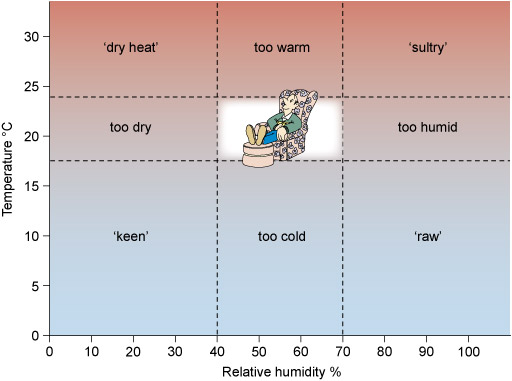Temperature and comfort
Activity 3 Temperature, warmth and coolness
We tend to think of somewhere comfortable as being somewhere that is warm in the winter and cool in the summer. What do you think the differences are between temperature, on the one hand, and warmth or coolness, on the other?
Discussion
Many people argue that these are the same thing, but you might think there is a significant difference. We usually think of temperature as a simple number that provides a measurement of the hotness or coldness of something. Warmth and coolness, on the other hand, have a feeling and value associated with them, especially in the context of a home. Warmth in the winter and cool in the summer makes us feel good, while temperature just ‘is’. Designers often make use of this distinction in their work. They aim to create a home that is warm or cool – and that can be done in a combination of ways, including the use of colour and materials – rather than a home that operates at a certain temperature.
It is in fact very difficult to reach universal agreement on the meaning of ‘comfort’; usually the best that can be done is to define it as an absence of discomfort. Discomfort is to be, for example, too hot or too cold. There are also considerable differences between the levels at which people begin to feel uncomfortable. For Europeans, the comfort range for air temperature is about 18 to 24 °C. However, what is ‘comfortable’ also depends very much on what you are doing at the time; strenuous physical activity needs a much lower air temperature for comfort than sitting in a chair. Figure 2 shows in very simplified form the ‘comfort zone’ for sedentary activity, in terms of temperature and humidity.

Obviously the UK temperature will sometimes fall within the comfort zone shown in Figure 2, and (if the other factors that influence comfort, such as air movement, are also within comfortable limits) at these times it is quite possible to be comfortable out of doors without any shelter. However, as you will probably know, in the UK, the number of days in a year in which all the comfort factors are satisfied is actually rather few. So, for a comfortable life, shelter from the elements is needed for most of the year in UK. A simple shelter would provide some protection (principally against wind and rain) and would be adequate for the few summer months, but for the rest of the year not only is shelter needed but also some more active forms of modifiers of the climate, particularly some form of heating.
